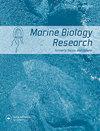pCO2升高对huxleyi球石藻对长时间黑暗响应的影响
IF 1.2
4区 生物学
Q4 ECOLOGY
引用次数: 0
摘要
尽管许多研究已经研究了球石藻对海洋酸化的反应,但对于这些钙化生物沉入海洋无氧区后的命运却知之甚少。本研究首先在20°C的12/12光/暗循环条件下生长,暴露于高(1000 μatm)和环境CO2 (410 μatm)环境中。然后将培养物在20°C或16°C下连续黑暗96 h。结果表明,CO2浓度升高降低了赫胥氏菌的特定生长率,增加了细胞颗粒有机碳(POC)和氮(PON)含量以及POC/PON比值。经过96 h的暗驯化,细胞丰度在20°C下比16°C下下降更明显,但两种CO2处理间差异不显著。在高CO2/20°C处理中,体积POC浓度的下降最为显著,在环境CO2/16°C处理中最小。在16°C时,PON浓度在高CO2培养中增加,而在环境CO2培养中没有变化。而在20°C时,高CO2和环境CO2条件下PON浓度均显著下降。最终POC/PON比值在不同温度和CO2处理间无显著差异。总的来说,随着二氧化碳浓度的增加,在黑暗中,相对于PON, POC的损失比例更高,这对海洋的营养循环有潜在的影响。本文章由计算机程序翻译,如有差异,请以英文原文为准。
Effects of elevated pCO2 on the response of coccolithophore Emiliania huxleyi to prolonged darkness
ABSTRACT Although numerous studies have examined the responses of coccolithophores to ocean acidification, less is known on the fate of those calcifying organisms when they sink to the ocean’s aphotic regions. In this study, the coccolithophore Emiliania huxleyi was first grown under a regular 12/12 light/dark cycle at 20°C, exposed to both high (1000 μatm) and ambient CO2 (410 μatm) levels. The cultures were then transferred to continuous darkness for 96 h at 20°C or 16°C. We found that elevated CO2 decreased the specific growth rate while increasing the cellular particulate organic carbon (POC) and nitrogen (PON) contents and the POC/PON ratio of E. huxleyi in the light/dark period. After 96 h of dark acclimation, the cell abundance decreased more obviously at 20°C than at 16°C but showed no significant difference between the two CO2 treatments. The decrease in volumetric POC concentration was most prominent in the high CO2/20°C treatment and least in the ambient CO2/16°C treatment. At 16°C, the PON concentration increased in the high CO2 cultures and exhibited no change in the ambient CO2 cultures. While at 20°C, the PON concentration decreased significantly both under high and ambient CO2 conditions. The final POC/PON ratio showed no significant differences among the different temperature and CO2 treatments. Overall, a higher percentage of POC relative to that of PON was lost in darkness with increasing CO2 concentration, with potential implications for the ocean’s nutrient cycle.
求助全文
通过发布文献求助,成功后即可免费获取论文全文。
去求助
来源期刊

Marine Biology Research
生物-海洋与淡水生物学
CiteScore
2.10
自引率
0.00%
发文量
55
审稿时长
6-12 weeks
期刊介绍:
Marine Biology Research (MBRJ) provides a worldwide forum for key information, ideas and discussion on all areas of marine biology and biological oceanography. Founded in 2005 as a merger of two Scandinavian journals, Sarsia and Ophelia, MBRJ is based today at the Institute of Marine Research, Bergen, Norway. The Journal’s scope encompasses basic and applied research from all oceans and marine habitats and on all marine organisms, the main criterium for acceptance being quality.
 求助内容:
求助内容: 应助结果提醒方式:
应助结果提醒方式:


